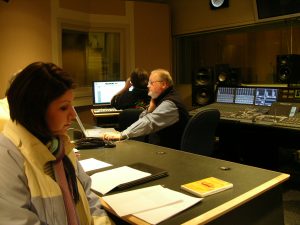Digital Heritage Audio Moment
Ray Hicks
Whether you are visiting the Coney Island Appalachian Festival, the Smithsonian Folklife Festival on the National Mall, or the Lake Eden Art Festival in Black Mountain, NC, there is one attraction that is sure to be a
A true Appalachian native, Ray was born near Boone, NC, on the same Beech Mountain farm where his grandfather and father were raised. There he spent his life with his wife Rosa. They lived in much the same fashion as previous generations: carrying water from the springhouse, gathering vegetables from their garden, and cooking on and staying warm from the heat provided by a wood stove. Ray enjoyed and carried on other family traditions like playing the harmonica, singing traditional ballads, and – most of all – storytelling.
As a boy, Ray was more interested in sitting at the feet of his Great Grandma Becky and Granddaddy Benjamin then he was in playing outside with the other children. His elders would tell him stories while they were doing small chores like canning, tanning groundhog hides, and drying apples. Ray remembered that as early as age five he was repeating those stories to his friends.
Jack Tales are akin to the well-known “Jack and the Beanstalk” and “Jack and the Giant-Killer.” The stories have their roots in ancient Celtic and European folklore. When Ray told them he would include Southern Appalachian references woven into the fanciful, fairy-tale narrative. The stories had a magical lure and often took more than an hour to complete – much to the delight of Ray’s audiences.
Ray’s first public storytelling, besides to family and close friends, came in 1951. He was the guest of schoolteacher Jennie Love at nearby Cove Creek Elementary School where he told his stories to her class. It went so well that Ray was asked back. On his second
Word soon spread of this giant treasure (Ray was six feet eight inches tall) that had been discovered in the rural mountains of western North Carolina. Ray began to perform at many events and festivals throughout the region. No venue was too small or too large. The first time he used a microphone, in 1973, he was standing on a flatbed truck at the very first National Storytelling Festival in Jonesboro, Tennessee. One witness said, “Ray stood ramrod straight, telling his Jack tale like the audience was in the sky.” Thirty-five people heard Ray that day, but the crowds soon grew. For the next thirty
Some wonderful memories come from the people who ventured up the mountain to visit Ray and Rosa in their home. The couple would always stop whatever chore they were doing to greet and welcome their guests. And those guests number in the hundreds, if not thousands. Linguists came to study Ray’s rhythms and dialect. News crews, journalists, and fans, young and old, made the pilgrimage. Ray would drawl his familiar “hey-lo” and settle on the porch while Rosa would beam with joy at all the fuss the world was making over her husband.
Ray would begin a story. One of his
Ray’s renown was certainly not limited to the Southern Appalachians. He was
Folklorist Bess Lomax Hawes may have described Ray best: “There isn’t any other Ray and never has been another Ray, except, maybe, back in the Middle Ages. He moves into a
Ray has been called a
Ray Hicks was diagnosed with cancer in 2001. When he died in 2003 at the age of 80 he was still telling stories, with great joy, to those that had gathered around his bed to say goodbye.
Multimedia:
1
for more information
- The Jack Tales by Ray Hicks as told to Lynn Salsi, 2000.
- Ray Hicks and the Jack Tales of Appalachia: Their Origins and Significance by Christine L. Pavesic, 2002.
- Performance, Culture, and Identity edited by Elizabeth C. Fine and Jean Haskell Speer, 1992.
- Beech Mountain Jack Tales, North Carolina Folklore Society, 1978.

